Grease Trap Inspection - One Source Real Estate Inspection 1-888-340-6566.
by Nick GromickoCommercial property inspectors, especially those who inspect food-handling establishments, can assist their clients in understanding the operation of grease traps so that their maintenance is not neglected. An inoperable or clogged grease trap can cause serious problems not only for the inspected establishment, but also for neighbors and even the entire local community.
Grease traps are plumbing devices designed to intercept fats, oils and grease -- collectively known as FOG -- before they enter a wastewater disposal system. FOG originates from the cleaning process of pots, pans, plates and silverware that contain food products such as deep-fried foods, meats, sauces, gravy, dressings, baked goods, cheese and butter.
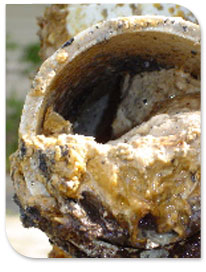
The terms “grease traps” and “grease interceptors” are often used interchangeably, but they are distinctly different technologies. While they both remove grease from water and operate by similar principles, here are some of their differences:
- Grease traps have a small capacity and are installed indoors and near the location where the grease is generated. They can be monitored and cleaned by restaurant employees and require no special equipment to clean.
- Grease interceptors are large, underground units (some having a capacity of several thousand gallons) that typically serve high-flow applications, such as larger restaurants, factories and grocery stores. To install a grease interceptor, a large trench must first be excavated and a cement footing built for support. The interceptor is placed into the trench where gravel is then poured to fill the space between the interceptor and the earth. An extension collar connects the buried interceptor with a manhole cover at ground level, approximately 30 inches above. Grease interceptors must be cleaned by licensed grease haulers who use specialized pumps and hoses.
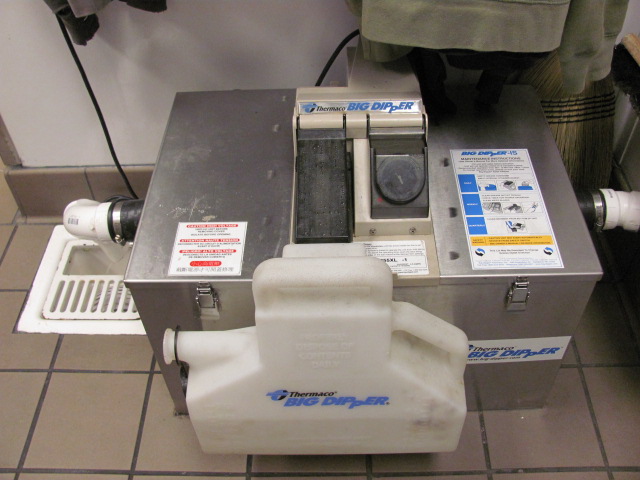
Grease traps and interceptors merely trap grease, so they should not be confused with automatic grease-removal units or grease converters. The former device employs hydrostatic pressure or a skimmer to clean itself, has more moving parts, and relies on motors, heaters and timers. Grease converters trap grease in a tank that contains bacteria and enzymes that digest the grease and convert it into a water-soluble biodegradable product that can be safely discharged into the drainage system.
How Do Grease Traps Work?
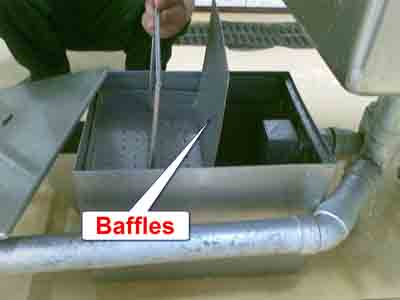
Without these devices, grease will enter sanitary sewer systems to create economic, safety and environmental hazards by clogging and damaging pipes and interfering with water-treatment plant operations. The U.S. Environmental Protection Agency estimates that nearly half of all the 400,000 sewer blockages that occur annually are caused by grease, and many of these contribute to the 40,000 annual sewer overflows. Even accumulated FOG that does not lead to an overflow or blockage may increase public maintenance and costs. Homeowners, business owners and municipalities are burdened by cleanup costs that can exceed $100,000 per incident. People may be responsible for overflows that are not their fault, as was the case in 2007 when the city of Fort Worth, Texas, declared immunity to severe damage caused to three residences when effluent from the public sewer system flooded their homes.
Restaurants are the most common source of FOG that causes backups, and they're particularly vulnerable to the resulting damage, often in the form of lost business during temporary closure, spoiled food, and injured reputation. The use of adequately sized and regularly inspected grease traps is thus mandated by local jurisdictions in restaurants, along with hotels, food-processing establishments, supermarkets, factories, and other places that routinely generate significant amounts of grease that would otherwise wind up in public sewers.
Inspection Checklist
InterNACHI commercial inspectors and business operators can use the following checklist for inspecting grease traps:
- proper capacity. If the traps are too small, they will not be able to prevent some of the FOG from entering the sewer system. If they are too large, they can promote the creation of hydrogen sulfide gas, which may be converted into hydrochloric acid, which can damage metal and concrete structures downstream.
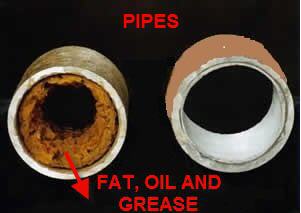 Traps are sized based on the combined flow rate of the connected fixtures, including the sink, dishwasher and mop drain. As a rough guide, the city of Newton, Massachusetts, requires that grease traps have a retention capacity of at least 2 pounds of grease for each gallon-per- minute of water flow. The type of food served may also be a factor in sizing, as especially greasy or fried foods will require a larger grease trap;
Traps are sized based on the combined flow rate of the connected fixtures, including the sink, dishwasher and mop drain. As a rough guide, the city of Newton, Massachusetts, requires that grease traps have a retention capacity of at least 2 pounds of grease for each gallon-per- minute of water flow. The type of food served may also be a factor in sizing, as especially greasy or fried foods will require a larger grease trap; - the presence of a flow-control valve. These T-shaped metal fittings control the rate of flow of wastewater into the trap and protect against sudden surges from the sink or other fixtures from overloading the system. They should be placed beyond the last connection from the fixtures and as close as possible to the underside of the lowest fixture. When two or more sinks or fixtures are combined and served by one trap, a single flow-control fitting can be used;
- the presence of an air intake for the flow-control valve. The flow-control device must be properly vented to permit air to mix with the fluid entering the interceptor to maintain adequate pressure. A vent will prevent a vacuum from forming within the trap, which can force water to enter the trap too quickly;
- proper clearance. Traps should be accessible for cleaning and inspection, whether located inside the kitchen, outside the building, or above or below ground;
- adequate distance from fixtures. Sources disagree over the proper distance that a grease trap should be installed from the fixtures being served. Some experts say that high temperatures may cause FOG to dissolve and exit the trap only to re-congeal once it cools in the sewer system, so traps should be installed some distance from dishwashers and other hot-water fixtures to allow time for the water to cool. Other sources, however, warn that placing the trap too far from fixtures will expose the building’s piping to grease buildup. Inspectors and restaurant owners can consult their authority having jurisdiction (AHJ) for local ordinances concerning appropriate water temperature and distance from fixtures of the grease trap;
- intact construction of the trap. It should be free of cracks in any part of the trap, including the baffles;
- whether the garbage disposal empties into the grease trap, which is not desirable. Ground food scraps will overload the trap and reduce its efficiency. Solid food scraps will also decay in the trap, creating unpleasant odors and unsanitary conditions;
- watertightness. Underground interceptors must be watertight to prevent the infiltration of groundwater or the escape of grease into groundwater or public sewers. Cracks should not be visible and the lid should be tight-fitting; and
- whether the grease trap has been re-purposed to serve multiple functions. Grease traps should never serve toilets or other sanitary systems.
It is important to understand that the grease trap’s efficiency diminishes as the trap fills with FOG, and when it is filled to capacity, it will no longer separate any FOG from water. The operator may not realize that the trap is full, however, as it will continue to accept water even after it fills, sending the unfiltered FOG directly into the sewer system. And because grease fills the trap from the top down (combined with variations in grease load), it can be difficult to know when the trap needs to be cleaned. And, unfortunately, cleaning grease traps, especially large units, is an unpleasant undertaking that may require restaurant operations to temporarily cease, so this important maintenance task is often neglected. Sometimes, too, amidst the hustle and bustle of a restaurant environment, the chore of cleaning the grease trap is simply forgotten.
The plumbing industry standard states that grease traps should be cleaned when 25% of the volume is occupied by grease (and 75% by water). Traps may need to be cleaned before hitting this threshold, however, so the operator will need to monitor the trap, particularly grease accumulation on the outlet baffle, to determine an appropriate cleaning schedule for the commercial enterprise.
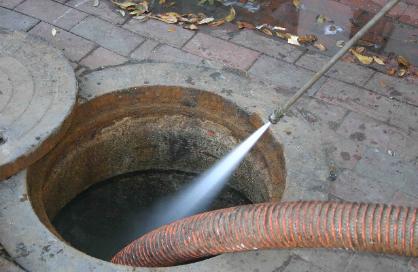
After disassembling the trap, the layer of FOG should be placed into a watertight bag or container and placed in the trash. Unlike “yellow grease” collected from deep-fat fryers that can be used in the production of biodiesel, soap and rubber, FOG is not recyclable and it must be placed in the trash. The interior sides, baffles and lid should then be scraped of FOG and cleaned. Rubber gloves should be worn and soap and antibacterial substances should be avoided during the cleaning process. When the trap is re-assembled, care should be taken to align the parts properly as, once flow is resumed, misaligned parts may allow overflowing and contamination of grease into the restaurant. While cleaning grease interceptors, care should be taken to avoid pinch points created by heavy manhole covers and to avoid damaging the rubber lining that prevents odors from escaping above ground. Any large items found at the bottom of the interceptor tank should be removed. One company reported having discovered a tricycle in their tank.
To reduce the need for cleaning the grease trap, unfinished food, fats, cooking oil and grease remaining in pots and pans should be dry-wiped or scraped out and into the trash prior to wet-washing. This measure can substantially reduce FOG discharged into the grease trap and prevent the release of foul sulfur gases into the commercial establishment.
In summary, grease traps and grease interceptors are plumbing devices required in food service facilities that prevent fats, oils and grease from entering the public sewer system. InterNACHI inspectors and business operators should learn how these devices work and how they are cleaned, maintained and inspected.
From Grease Trap Inspection - InterNACHI http://www.nachi.org/grease-trap-inspection.htm#ixzz2jRdikhbU


No comments:
Post a Comment